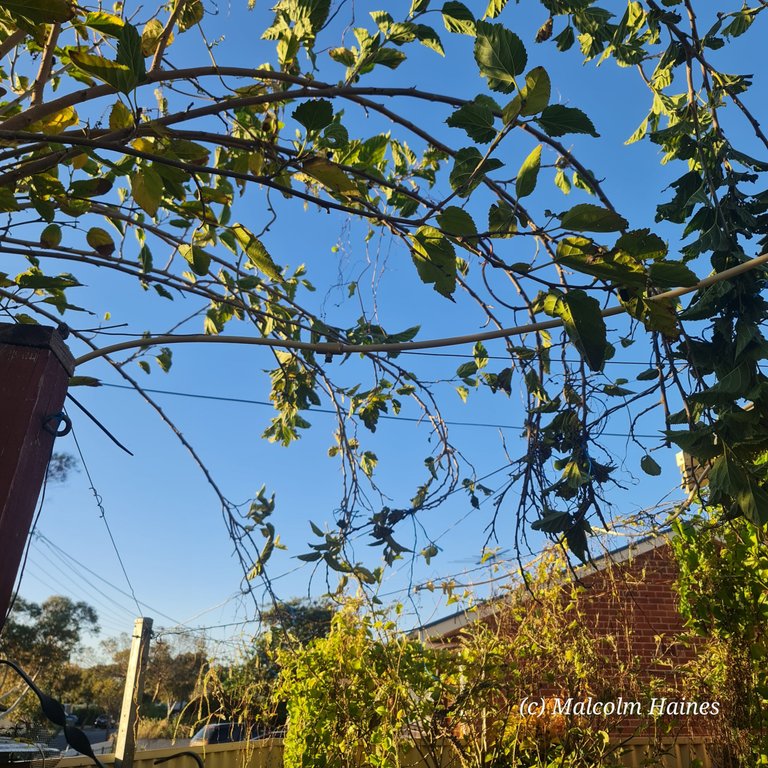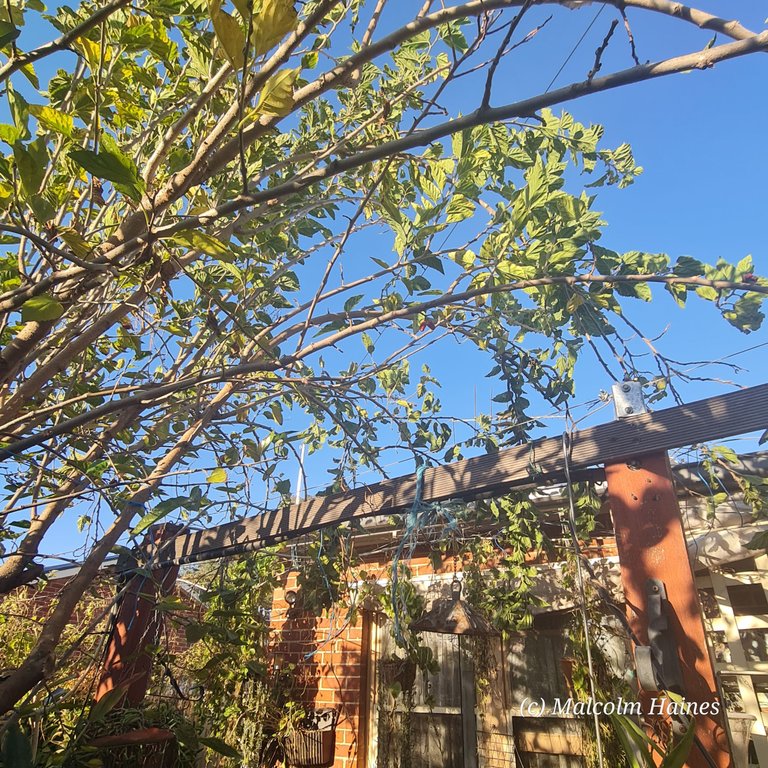Training the Mulberry arbor

Last year (was it that long ago?), we decided to build a little verandah to protect the lounge room window. But I had a thought (and a decided lack of cash) when looking out one day at our ‘dwarf’ Mulberry.
This dwarf tree reaches 6-8 metres every year and we lose a lot of berries because of their inaccessibility and the fact that they are frequently knocked off of their branches by the movement of their whippy growth (I put a piece about this in the current subscriber’s newsletter).
Jelina is a weaver and I’m aware of folks weaving willow branches and I have a philosophy of letting the plants do the work. That and I didn’t want to prune the tree.
Combining these ideas, I thought ‘why not use the Mulberry branches’? They’re long, flexible and will bear fruit. It’ll be a great way to use that super-vigorous growth of the Mulberry in a way that we can directly use. I suppose we can call it 'edible architecture'.

We already had the wire cables that support the vines in place, so all I had to do was give the tree a light prune so that I could better see what I was doing, choose the best branches and pull them over (harder than it sounds) and tie them off on the appropriate cable. Currently, I’m just using the cables that are there but I may reposition them later as I see how things develop.
I chose branches that were further back from the house and as long as possible so that I could build a decent arc into the structure. I wanted to get more head space than we had with the vines. Space is at a premium in our garden and even just the illusion of it or height helps.
Later, these branches can be trimmed and the new growth from them, which grows vertically, can be then arced to extend the whole mess closer to the house.
I’ll keep you in the loop as it progresses.
Some of you may have seen that I've been writing a series of posts about herbs and making herbal remedies at home. I want to share what I know of this topic so that, as the world gets crazier, folks will have other avenues of medical care, namely those of themselves and their community. If you look back over this blog, you can see heaps of info on the topic, plus loads and loads of posts on herbs and using Australian bushfoods from a white perspective. If you haven't been around on in the @hivegarden and @naturalmedicine communities for long, you may be interested in looking back. There's w-a-a-a-a-y too much there for me to repost and the Hive system doesn't let you vote on old posts so, if you're happy with what you find, I believe that there is now a tip option...






That is such a good idea. The mulberry is such a sturdy plant with beautiful leaves - your arbor will be gorgeous for sure. You will also have easier access to the fruit. Great solution.
Thank you.
Hi, ma'am good evening I hope you are having a great weekend and doing well. I see you use the Mulberry plant as a harbor It was a brilliant idea rather than spending money to have one built the cost of materials, and labor is ridiculous nowadays. Plus the Mulberry plant gives a natural view and It will be very pleasant to the eyes when it blooms, the colors of the ripened fruit surely add more beauty to the structure. Thank you so much ma'am for sharing your ideas with us.
I am Filipino and I have seen a few homes using Bougainvillea to grow over harbors, by the windows to protect maniacs from breaking in the thorny vines sometimes do the job.
Salamat. My wife wants a Bougainville for the sane readins you mention - security. Plus the potent medicines that van be made from the plants.
What a cool idea! I sure hope it works as you need it to.
Thabks. It should, I'm just copying nature and that usually (?) Works
Can't wait to see the eventual finished growth.
Thanks! It should be great!
Good morning, friend, it was a total good idea to used the mulberry branches for architecture, I see it as using one thing to achieve two, you have done awesome.
😁
@ligayagardener, I paid out 0.578 HIVE and 0.115 HBD to reward 5 comments in this discussion thread.
Awesome! Keep up the great work